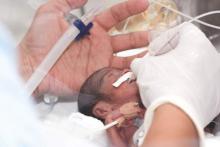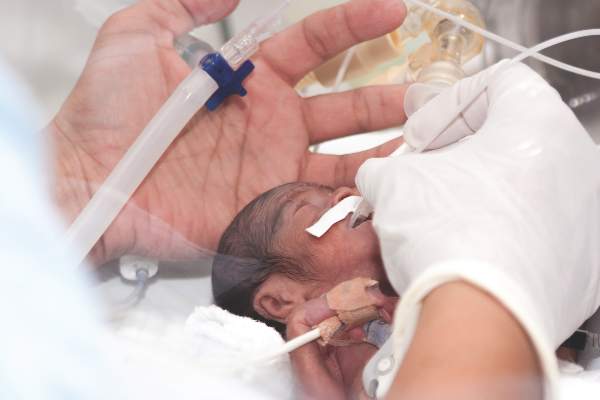User login
Low cost, low-risk interventions can significantly lower the rate of necrotizing enterocolitis among very-low-birth-weight (VLBW) infants, according to a study published in Pediatrics.
Dr. Maria M. Talavera of the department of pediatrics at Ohio State University, Columbus, and her associates assessed the effects of a multipronged intervention on the rate of necrotizing enterocolitis (NEC) among VLBW infants admitted to the intensive care nurseries of Nationwide Children’s Hospital between January 2010 and December 2013. The intervention involved three initiatives: standardized early human milk feedings, standardized restrictive feedings during blood product transfusion and indomethacin therapy, and restrictive ranitidine use in infants of 1,500 g or less or aged 28 weeks or less (Pediatrics. 2016;137[5]:e20151119).
The study produced a collection of interesting findings, most of which suggested a high degree of success in reducing the rate of NEC among VLBW infants. In 2010, the baseline rate of necrotizing enterocolitis in this patient population was 8% of 335 infants. From November 2011 through December 2013, implementation of the interventional plan resulted in a rate of 3.1% of 606 infants.
Additionally, the percentage of discharged infants fed their mother’s own milk by day 3 of life showed a stepwise increase from 0% before September 2010 to 30% from October 2010 to September 2011, and increased to 50% by January 2012.
Perhaps most importantly, mortality among this population of infants attributable to NEC at Nationwide Children’s Hospital nurseries dropped from a baseline mean of 2.7% prior to the implementation of the interventional plan in 2010 to a sustained rate of 0.9% from 2011 to 2013.
Dr. Talavera and her associates cited the lack of a control nursery that did not implement these interventions as a major limitation of their study, but the study results would seem to make an excellent case for implementation of this simple, low-risk, low-cost interventional plan to reduce NEC among VLBW infants.
No external funding was provided. None of the authors reported any conflicts of interest.
Low cost, low-risk interventions can significantly lower the rate of necrotizing enterocolitis among very-low-birth-weight (VLBW) infants, according to a study published in Pediatrics.
Dr. Maria M. Talavera of the department of pediatrics at Ohio State University, Columbus, and her associates assessed the effects of a multipronged intervention on the rate of necrotizing enterocolitis (NEC) among VLBW infants admitted to the intensive care nurseries of Nationwide Children’s Hospital between January 2010 and December 2013. The intervention involved three initiatives: standardized early human milk feedings, standardized restrictive feedings during blood product transfusion and indomethacin therapy, and restrictive ranitidine use in infants of 1,500 g or less or aged 28 weeks or less (Pediatrics. 2016;137[5]:e20151119).
The study produced a collection of interesting findings, most of which suggested a high degree of success in reducing the rate of NEC among VLBW infants. In 2010, the baseline rate of necrotizing enterocolitis in this patient population was 8% of 335 infants. From November 2011 through December 2013, implementation of the interventional plan resulted in a rate of 3.1% of 606 infants.
Additionally, the percentage of discharged infants fed their mother’s own milk by day 3 of life showed a stepwise increase from 0% before September 2010 to 30% from October 2010 to September 2011, and increased to 50% by January 2012.
Perhaps most importantly, mortality among this population of infants attributable to NEC at Nationwide Children’s Hospital nurseries dropped from a baseline mean of 2.7% prior to the implementation of the interventional plan in 2010 to a sustained rate of 0.9% from 2011 to 2013.
Dr. Talavera and her associates cited the lack of a control nursery that did not implement these interventions as a major limitation of their study, but the study results would seem to make an excellent case for implementation of this simple, low-risk, low-cost interventional plan to reduce NEC among VLBW infants.
No external funding was provided. None of the authors reported any conflicts of interest.
Low cost, low-risk interventions can significantly lower the rate of necrotizing enterocolitis among very-low-birth-weight (VLBW) infants, according to a study published in Pediatrics.
Dr. Maria M. Talavera of the department of pediatrics at Ohio State University, Columbus, and her associates assessed the effects of a multipronged intervention on the rate of necrotizing enterocolitis (NEC) among VLBW infants admitted to the intensive care nurseries of Nationwide Children’s Hospital between January 2010 and December 2013. The intervention involved three initiatives: standardized early human milk feedings, standardized restrictive feedings during blood product transfusion and indomethacin therapy, and restrictive ranitidine use in infants of 1,500 g or less or aged 28 weeks or less (Pediatrics. 2016;137[5]:e20151119).
The study produced a collection of interesting findings, most of which suggested a high degree of success in reducing the rate of NEC among VLBW infants. In 2010, the baseline rate of necrotizing enterocolitis in this patient population was 8% of 335 infants. From November 2011 through December 2013, implementation of the interventional plan resulted in a rate of 3.1% of 606 infants.
Additionally, the percentage of discharged infants fed their mother’s own milk by day 3 of life showed a stepwise increase from 0% before September 2010 to 30% from October 2010 to September 2011, and increased to 50% by January 2012.
Perhaps most importantly, mortality among this population of infants attributable to NEC at Nationwide Children’s Hospital nurseries dropped from a baseline mean of 2.7% prior to the implementation of the interventional plan in 2010 to a sustained rate of 0.9% from 2011 to 2013.
Dr. Talavera and her associates cited the lack of a control nursery that did not implement these interventions as a major limitation of their study, but the study results would seem to make an excellent case for implementation of this simple, low-risk, low-cost interventional plan to reduce NEC among VLBW infants.
No external funding was provided. None of the authors reported any conflicts of interest.
FROM PEDIATRICS
Key clinical point: A simple three-part intervention can significantly lower the rate of necrotizing enterocolitis among very-low-birth-weight infants.
Major finding: In 2010, the baseline rate of necrotizing enterocolitis in this patient population was 8% of 335 infants. From November 2011 through December 2013, implementation of the interventional plan resulted in a rate of 3.1% of 606 infants.
Data source: VLBW infants admitted to eight intensive care nurseries from January 2010 to December 2013.
Disclosures: No external funding was provided. None of the authors reported any conflicts of interest.

